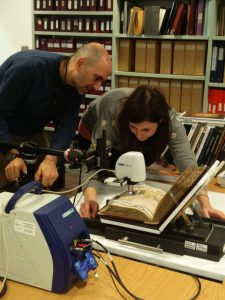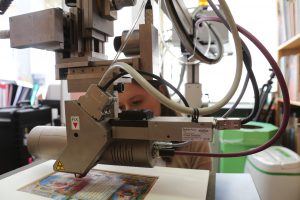If a friend asked me to sum up in brief my first month at work in the Scientific Laboratory of the Fitzwilliam Museum, I would reply, “It has been a crash course in technical analyses of magnificent artworks!” I kick-started the New Year by moving to Cambridge to begin a fellowship as a Research Assistant of the MINIARE Project – Manuscript Illumination: Non-Invasive Analysis, Research and Expertise. Since 2012, the project has carried out scientific investigation of the materials and techniques used to make medieval and Renaissance illuminated manuscripts, while studying the cultural, historical and art-historical context of production.
During the first two weeks, I had the opportunity to catch a glimpse of the rich and diverse collections that the Fitzwilliam Museum houses, crossing the Art History timeline – from ancient Egyptian coffins to French impressionists – simply by walking through the galleries. Among the collections, I became especially acquainted with the Western illuminated manuscripts, which are the focus of in-depth study and conservation for the Department of Manuscripts and Printed Books. Curators and conservators of this Department introduced me into the world of ancient books, making me aware of the conservation needs of unique and fragile artworks, how to choose appropriate temperature, humidity, and lighting conditions, as well as how best to handle the manuscripts before and during the analyses.
Coincidently, the next three weeks fell at the moment visiting researcher Dr Stefano Legnaioli from ICCOM-CNR of Pisa, Italy, came to the Fitzwilliam Museum to carry out analysis of selected objects through Raman spectroscopy. Among the scientific techniques that can be used to examine artworks non-invasively (i.e. without taking samples or touching the artwork’s surface), Raman spectroscopy is one of the most reliable to identify artists’ materials. To enable precise identification, more information was also collected using additional analysis techniques available in the Museum’s Analytical Lab.

I assisted with the installation of a multi-analytical ‘mobile’ laboratory and helped Dr Legnaioli and the Museum’s Research Scientist, Dr Paola Ricciardi, in performing the analyses. In the brief time available, I was fortunate to be able to work on a ninth-century French manuscript, a lavish copy of the Astronomicum Caesareum printed in the mid-sixteenth century, Corpus Christi College’s Grant of Arms, a group of sixteenth-century Italian Dogali (ducal documents from the Republic of Venice), as well as on some of the Museum’s fan collection.

Our daily protocol included multispectral imaging and spectroscopic analyses: X-ray fluorescence (XRF), reflectance spectroscopy in the ultraviolet-visible-shortwave infrared range (FORS) and Raman. The combination of these analyses revealed underdrawing, changes in the composition, retouching and ultimately the nature of the vibrant and rich colour palettes. The scientific data that we have collected can support other researchers to shed light on the objects’ authorship, style and geographic origin, and ultimately to educate the visitors on how the artefacts were made.

This intensive experience enhanced my knowledge of illuminated manuscripts greatly, and above all, it taught me how to study this type of artefact with a scientific approach. I learned that, even if at first glance a colour palette seems to be easy to identify, analysis can reveal unexpected and unusual results. I understood early on that science cannot answer all the questions that arise at the beginning of research; however, this is a challenge rather than a failure. It may be that we need to find or develop a new protocol, perform other analyses, discuss the problem with curators, or even to leave the question open and unanswered. I loved doing this cross-disciplinary research because, like a jigsaw puzzle, all the various chemical, physical and historical information can be put together to resolve the manuscripts’ mysteries.
I have just completed the first month of my fellowship at the Fitzwilliam Museum and I look forward to facing new challenges and studying in-depth the art of illumination. With plenty of work to do this year, I am sure there will be new scientific discoveries to write about in future blog posts! I would like to thank the Zeno Karl Schindler Foundation for supporting and funding the MINIARE fellowship, as a remarkable experience for my professional and personal growth.
